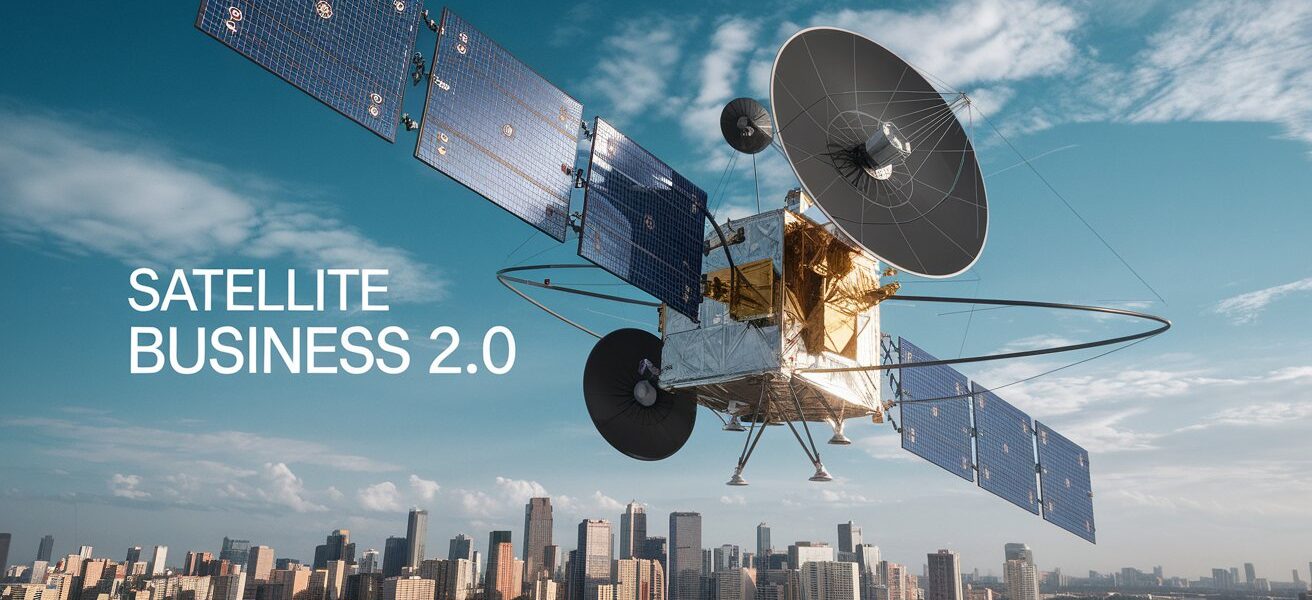The satellite industry has come a long way over the last few decades and has evolved from being an industry mainly controlled by big governments and multibillion-dollar organizations to being more liberal. This new evolution of satellite business is symbolized by use of the term Satellite Business 2.0 due to the change in technology, private sector interest, and new models of business. Because of the steady rising demand of satellite data, communication services and space based applications.
What is Satellite Business 2.0?
Satellite Business 2.0 is the second manifestation of growth and innovation in satellite industries. Whereas Satellite Business 1.0 was visibly dominated by government programs and only a few large, traditional satellite manufacturers, the Satellite Business 2.0 is based on a rapidly expanding extended “space ecosystem” of numerous private enterprises, new space startups, and international space agencies.
Characteristics of Satellite Business 2.0.
Satellite Business 2.0 is driven by several key characteristics that set it apart from its predecessor:
- Private Sector Involvement: Today, vehicles, satellite manufacturing, and launch services are conducted by firms such as SpaceX, Blue Origin and others and OneWeb.
- Miniaturization of Satellites: For various purposes, innovative systems, such as CubeSats and nano-satellites, defined as miniature satellites and having comparatively lower costs, are being used.
- Increased Accessibility: Improved costs in satellite fabrication and launching services have made space endeavors possible for lesser known small firms, universities, and enthusiasts.
- Data-Driven Economy: It has been found that the need for satellite-derived information for agricultural, mining, and Telecommunication businesses especially has surged.
How small satellite businesses have grown
Satellites business 2.0 has been greatly driven by the Internet of things and small satellite market. Historically, deploying a satellite was a hugely capital intensive process and fairly time consuming, up to today, small satellites can be developed and deployed at relatively low costs. These small satellites can be used for various applications like Earth observation, communication, scientific research which hence provide new business models for innovation forrupts and SMBs.
Small Satellite Trends
The market sizes of small satellites are expected to double in the next ten years due to the increasing demand. Categorized by end-use, it was found that the small satellite market should reach approximately $13.7 billion by 2030, based on market research information. A few trends contributing to this growth include:
- Constellations of Satellites: Lately, many ventures such as SpaceX’s Starlink, are using a large number of tiny satellites to achieve world coverage of the internet.
- Advances in Propulsion and Power Systems: Technological advances are enabling propulsion of small satellites that are more agile and thus increasing longevity of their service.
- Commercial Payload Opportunities: Some of the opportunities include; Commercial Payloads where operators of small satellites offer  space for rent there is opportunity for other satellite operators to generate other kinds of revenue.
Technologies that Will Drive Satellite Business 2.0
Satellite businesses have become more viable and accessible due to advanced technology allowing the fast growth of the sector.
CubeSats and Nano-Satellites
As for the greatest innovations for Satellite Business 2.0, the creation of CubeSats and nano-satellites is the most important. However, CubeSats are less expensive to develop and launch about than large satellites, making them attractive to firms and academic institutions. They can be employed for a number of application like as meteorological surveillance, navigation of shipping, or experimentation of the newest equipments.
Reusable Rockets
SpaceX’s reusable rocket technology has cut down the expenses related to launching satellites into orbit tremendously. By reusing and refitting rockets after a mission, as opposed to building new ones every time, many millions of dollars per launch can be saved and traditional satellite operators not necessarily primarily engaged in the space transport business dealing with start-ups and international organizations may find it cheaper to launch satellites.
AI & ML
Artificial intelligence and machine learning are now merged with the satellite function more and more. Such application of these technologies can enhance the positioning of satellite, handling and controlling of communication networks, and good processing of data acquired from satellites in real-time. This has creating opportunities for satellite data services especially in facets like disaster management, environment and agriculture.
5G and Beyond
The use and implementation of 5G networks will also facilitate the occurrence of complementarities in the satellite industry. As it has been noted above, satellites can act as the so-called ‘backhaul or midhaul’ in the extension of 5G to areas where direct terrestrial connection is impossible. For example, it is potential that the subsequent generations of the networks, including 6G, would be more dependent on satellites.
Preliminary Measures for Engaging on the Satellite Commerce 2.0
key issues for the entrepreneur or business that want to enter the satellite market include: Below are steps that can be taken when engaging in satellite business.
-
Identify Your Niche
Satellite industry is a very large and general market that consists satellite manufacturing and launch services, data services, and ground segments. The first step is to choose a specific area where the company can improve the present offers. Some potential areas to consider include:
- Satellite Communication: This involves offering Internet or data communications, for example through use of satellite.
- Earth Observation: Providing satellite imagery services for sectors such as farming, city design, or calamity response.
- Navigation Systems: Creating systems that will improve GPS and navigation assistance.
-
Secure Funding
Although costs have reduced it still takes a lot of money to get into the satellite industry. Depending on your business you may require venture capital, grants from government, or equity funding to support your business. Governments around the world pour money into space technology research, and thus hunting down grants is not a waste of time.
-
Sample: Leverage on the current prominent market players
One of the most important sources is cooperation with experienced satellite companies or Space Agency, this experience will help your business to become successful. A lot of startups share a launch vehicle with established providers like SpaceX or Rocket Lab to place their satellites in orbit cheaper.
-
Find Out Better Compliance with Latest Regulatory Laws
Satellite industry is highly governed hence financial institutions as well has to abide by the national and international laws. For instance, to use satellite communications you’ll have to get permits, and to place satellites into orbit you’ll need the consent of space agencies.
The Commercialization of Space: Opportunities and Challenges
Satellite Business 2.0 is a phenomenon within a larger global shift towards commercialisation of space known as “New Space.” This shift is full of enormous opportunities for both innovation and profit, but it also has severe problems.
Opportunities in New Space
Space Tourism: Some organizations such as SpaceX and Blue Origin are currently flying tourist to space for orbital flights and suborbital flights are also available for use and this sector is expected to expand as technology advances.
- Asteroid Mining: As clearly behind the theory, asteroid mining could open access to materials and resources that would represent a whole new niche for space travel.
- Satellite-Based IoT: IoT has made it possible for satellites to create global connectivity for devices in business so as to create new models for data acquisition and analysis.
We look at the challenges over the satellite business Some of the challenges affecting the satellite business include;
- Space Debris: The issue of Space debris is as follows: the more satellites are launched the more intense the problem becomes. Businesses are going to have to dedicate funds into handling and addressing space debris.
- Cybersecurity Threats: Since people rely on satellite communication for critical services, the issue of cyber defense is an important point. Protecting satellite networks will be major critical success factor for this industry.
- Competition and Market Saturation: The favourable conditions for new satellite businesses add new competition forces. Such a highly saturated competitive environment indeed puts pressure on companies to arrive at unique services and business formulations.
Conclusion
Satellite Business 2.0 is much greater than a field evolution; it is the commercial environment of outer space. There is and will ever be enormous market potential, constantly lowering costs, and upcoming technologies that remain untapped and hold virtually endless potential for growth and diversification. For more details on these aspects, refer to the book Satellite Business 2.0 for Entrepreneurs and Business Opportunities and success factors for fast Change in GrowingChannel Markets.





